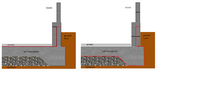Hi guys.
So I want to build a large shed at the bottom of the garden (some of you may have seen my other post). Im going to build it out of block.
My only issue with it is, I need 2.5m clearance between the floor and the roof (enough room to swing a golf club basically).
My neighbours garages are exactly 2.5m tall, so I don't really want to go down the planning permission route and build it a foot higher as it will be an eye sore, and I have to go through the game of getting planning permission in the first place, so ideally id like it to be within permissible build dimensions.
With permissible build in mind, to get the 2.5m internal heigh I need, when considering the depth of the roof and its joists, id need to go down around a foot.
When building below ground level, what would be the best way to keep damp and moisture out? Ive never done this before. Are there any resources I could look up that explain what is needed?
I have a concrete garage than someone build below ground level, it has no DPM and the joins in the concrete leak like a sinking ship. Natrually I cant have this with my new build.
Thanks
So I want to build a large shed at the bottom of the garden (some of you may have seen my other post). Im going to build it out of block.
My only issue with it is, I need 2.5m clearance between the floor and the roof (enough room to swing a golf club basically).
My neighbours garages are exactly 2.5m tall, so I don't really want to go down the planning permission route and build it a foot higher as it will be an eye sore, and I have to go through the game of getting planning permission in the first place, so ideally id like it to be within permissible build dimensions.
With permissible build in mind, to get the 2.5m internal heigh I need, when considering the depth of the roof and its joists, id need to go down around a foot.
When building below ground level, what would be the best way to keep damp and moisture out? Ive never done this before. Are there any resources I could look up that explain what is needed?
I have a concrete garage than someone build below ground level, it has no DPM and the joins in the concrete leak like a sinking ship. Natrually I cant have this with my new build.
Thanks


